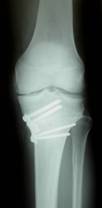The word osteotomy literally means the ‘cutting of bone’. Although the breaking of bone and resetting it in a more favourable position sounds very drastic this tried and tested treatment option for knee arthritis can yield very good results. Osteotomy is used to alter the weight bearing mechanical axis through the knee to decrease arthritic pain.
Most patients who would be suitable for knee osteotomy are generally under the age of fifty-five. The typical patient is one who has suffered an injury of the knee resulting in significant meniscal damage and subsequent removal of the damaged meniscus. Loss of the shock absorber either on the inside or outside of the knee may in the long run lead to a bow-legged or knock-kneed deformity respectively. This deformity is accompanied by the early onset of osteoarthritis. By performing an osteotomy around the knee it is possible to move the line of weight bearing away from the damaged arthritic area and onto the healthier and pain-free area of the knee.
Osteotomies can be made either at the top of the tibia or the lower end of the femur. The exact position of the bone cut is made by physical examination and x-rays of the whole leg to ascertain the degree of correction required to restore a more normal alignment of the leg. The most common osteotomy is a ‘high tibial osteotomy’ to correct bow-leggednees. In this case a small incision is made at the top of the tibia on the inside and the bone is carefully and accurately cut across its width. The leg is straightened by opening up the cut bone and wedging it open with a small metal plate, screws and some bone graft to promote healing.

Post-operative x-ray of a high tibial osteotomy with small plate and four screws. The osteotomy is still just about visible between the screws.
The operation takes about one hour and usually is performed under a general anaesthesia through a 5cm incision at the top of the tibia. After the operation the patient is placed in a hinged knee brace for at least six weeks depending on how healing is progressing. In-patient stay is between 2 to 3 days. It is extremely important to start knee bending as soon as possible after the operation. Crutches will be required for much of this time with a limited period of non- or minimal weight bearing depending on the exact nature of the procedure. The bone usually heals after about two months and x-rays are required to confirm this.
The aim of osteotomy is to reduce knee pain and protect the remaining healthy cartilage in the knee from further damage. Research has shown that clinical benefit is derived from osteotomy for about 8-10 years. Thereafter it is possible that total knee replacement will be required.
As with every procedure there are rare complications. These include infection, blood clot, neurovascular damage, metal work failure, incomplete symptom relief and delayed or non-union (failure to heal) of the bone. This last risk is particularly increased in patients who smoke.
The number of osteotomies performed around the knee for arthritis is slowly decreasing in the UK due to the increased benefit that a total knee replacement can offer a young patient especially with the latest bearing surfaces such as oxinium (see oxinium knee replacement). Nevertheless osteotomy remains a procedure with an excellent track record and will always be one surgical option for the young patient with knee arthritis.
